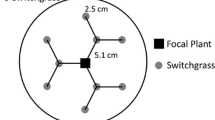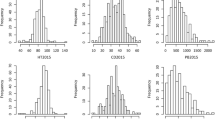Abstract
Prairie cordgrass (Spartina pectinata Link) has potential as a bioenergy crop in poorly drained cropland in much of temperate North America. Our objectives were (1) describe morphological differences between two prairie cordgrass populations and switchgrass for biomass production and pattern of biomass accumulation in leaf and stem tissue, (2) estimate genetic variation for biomass production and other agronomic traits in a population of prairie cordgrass from South Dakota, and (3) increase knowledge of the impact of insects on biomass production of prairie cordgrass. On poorly drained cropland in South Dakota, a natural population of prairie cordgrass (SD CG) from South Dakota produced 75% more biomass than a natural population from North Dakota, and a selected population of prairie cordgrass produced >2 times the biomass of switchgrass. However, when prairie cordgrass was fed on by larvae of the four-lined borer [(Resapamea stipata (Morr.)], yield of the two species was similar. Prairie cordgrass had a lower frequency of reproductive tillers (RTRs) and larger leaves than switchgrass. SD CG had high genetic variation for disease resistance, moderate genetic variation for biomass yield, and low genetic variation for inflorescences m−2. Seven out of 57 half-sib families from SD CG produced more biomass than “summer” switchgrass during a year with normal precipitation, whereas only one family did so during a drought year. RTR declined rapidly with stand age. The four-lined borer was identified as a serious threat to biomass production of prairie cordgrass in eastern South Dakota.

Similar content being viewed by others
References
Madakadze IC, Coulman BE, McElroy AR et al (1998) Evaluation of selected warm-season grasses for biomass production in areas with a short growing season. Biores Tech 65:1–12
Skinner RH, Zobel RW, Grinten M, Skaradek W (2009) Evaluation of native warm-season grass cultivars for riparian zones. J Soil Water Conserv 64:413–422
Boe A, Springer T, Lee DK, Rayburn AL, Gonzalez-Hernandez J (2013) Underutilized grasses. In: Saha MC, Bhandari HS, Bouton JH (eds) Bioenergy feedstocks: Breeding and genetics. Wiley, Ames, pp 173–205
Clark S (2013) Kingston Germplasm prairie cordgrass release brochure (ID#11934). USDA-NRCS Big Flats Plant Materials Center, Corning
Kim S, Rayburn AL, Voigt T et al (2012b) Salinity effects on germination and plant growth of prairie cordgrass and switchgrass. BioEnerg Res 5:225–235
Boe A, Owens VE, Gonzalez-Hernandez J, Stein J, Lee DK, Koo BC (2009) Morphology and biomass production of prairie cordgrass on marginal lands. GCB Bioenergy 1:240–250
Weaver JE, Fitzpatrick TJ (1934) The prairie. Ecol Monograph 4:109–295
Weaver JE, Fitzpatrick TJ (1932) Ecology and relative importance of the dominants of the tall-grass prairie. Bot Gaz 93:113–150
Mobberley DG (1956) Taxonomy and distribution of the genus Spartina. Iowa St Coll J Sci 30:471–574
Jensen N (2013) Prairie cordgrass. Plant Guide for prairie cordgrass (Spartina pectinata Bosc ex Link). USDA-NRCS Bismarck Plant Materials Center, Bismarck (http:www.nrcs.usda.gov/Internet/FSE_PLANTMATERIALS/publications/nypmcpg11942.pdf)
Snee S (2013) Notice of release of Southampton germplasm prairie cordgrass (ID#11919). Cape May Plant Materials Center, Cape May Court House (www.nrcs.usda.gov/Internet/FSE_PLANTMATERIALS/publications/njpmcrn11919.pdf)
Boe A, Lee DK (2007) Genetic variation for biomass production in prairie cordgrass and switchgrass. Crop Sci 47:929–934
Guo J, Thapa S, Voigt T, Rayburn AL, Boe A, Lee DK (2015) Phenotypic and biomass yield variations in natural populations of prairie cordgrass (Spartina pectinata Link) in the USA. BioEnerg Res 8:1371–1383
Potter L, Bingham MJ, Baker MG, Long S (1995) The potential of two perennial C4 grasses and a perennial C4 sedge as lingo-cellulosic fuel crops in N.W. Europe. Crop establishment and yields in E. England. Ann Bot 76:513–520
Zilverberg CJ, Johnson WC, Boe A et al (2014) Growing Spartina pectinata in previously farmed prairie wetlands for economic and ecological benefits. Wetlands 34:853–864
Boe A, Owens VE, Gonzalez-Hernandez J, Lee DK (2013) Seed set in prairie cordgrass. Crop Sci 52:403–410
Decker GC (1930) The biology of the four-lined borer [Luperina stipata (Morr.)]. Iowa State Coll Agric Mechanic Arts Agric Exp Sta Res Bull No 125
Ainslie CN (1917) A few notes on the life history of Phalonia spartinana. Canadian Entomol 49:93–96
Prasifka JR, Lee DK, Bradshaw JD, Parrish AS, Gray ME (2012) Seed reduction in prairie cordgrass, Spartina pectinata Link., by the floret-feeding caterpillar, Aethes spartinana (Barnes and McDonnough). BioEnerg Res 5:189–196
Sanderson MA (1992) Morphological development in switchgrass and kleingrass. Agron J 84:415–419
Harper JL (1985) Modules, branches, and the capture of resources. In: Jackson JBC, Buss LW, Cook RE (eds) Population biology and evolution of clonal organisms. Yale Univ. Press, New Haven, pp 1–34
Gustafson DM, Boe A, Jin Y (2003) Genetic variation for Puccinia emaculata infection in switchgrass. Crop Sci 43:755–759
Nguyen HT, Sleper DA (1983) Theory and application of half-sib matings in forage grass breeding. Theor Appl Gen 64:187–196
Thompson JD, McNeilly T, Gray AJ (1991) Population variation in Spartina anglica C.E. Hubbard. II. Reciprocal transplants among three successional populations. New Phytol 117:129–139
Castellanos M, Heredia C, Figueroa ME, Davy AJ (1998) Tiller dynamics of Spartina maritima in successional and non-successional Mediterranean salt marsh. Plant Ecol 137:213–225
Moore KJ, Moser LE (1995) Quantifying developmental morphology of perennial grasses. Crop Sci 35:37–43
Casler MD, Boe A (2003) Cultivar x environment interactions in switchgrass. Crop Sci 43:2226–2233
Berdahl JD, Frank AB, Krupinsky JM, Carr PM, Hanson JD (2005) Biomass yield, phenology, and survival of diverse switchgrass cultivars and experimental strains in western North Dakota. Agron J 97:549–555
Kim S (2014) Biomass production and quality of prairie cordgrass (Spartina pectinata Link) using urea and kura clover (Trifolium ambiguum Bieb.) as sources of nitrogen. PhD Diss. South Dakota State University, Brookings
Reidenbaugh TG (1983) Tillering and mortality of the salt marsh grass, Spartina alterniflora. Amer J Bot 70:47–52
Gallagher JL, Somers GF, Grant DM, Seliskar DM (1988) Persistent differences in two forms of Spartina alterniflora: A common garden experiment. Ecology 69:1005–1008
Johnson SR, Knapp AK (1996) Impact of Ischnodemus falicus (Hemiptera: Lygaeidae) on photosynthesis and production of Spartina pectinata wetlands. Environ Entomol 25:1122–1127
Wheeler AG (1996) Ischnodemus falicus (Heteroptera: Lygaeidae): First record from ornamental grasses, and seasonality on prairie cordgrass in Pennsylvania. Proc Entomol Soc Wash 98:195–198
Prasifka JR, Bradshaw JD, Boe A et al (2010) Symptoms, distribution and abundance of the stem-boring caterpillar, Blastobasis repartella (Dietz) in switchgrass. BioEenerg Res 3:238–242
Calles-Torrez V, Johnson PJ, Boe A (2013) Infestation rates and tiller morphology effects by the switchgrass moth on six cultivars of switchgrass. BioEnerg Res 6:808–812
Boe A, Gagné RA (2011) A new species of gall midge (Diptera: Cecidomyiidae) infesting switchgrass in the Northern Great Plains. BioEnerg Res 4:77–84
Calles-Torrez V, Johnson PJ, Boe A (2014) The switchgrass gall midge (Chilophaga virgati Gagné) in the Northern Great Plains. BioEnerg Res 7:417–423
Boe A, Beck DL (2008) Yield components of biomass in switchgrass. Crop Sci 48:1306–1311
Boe A (2007) Variation between two switchgrass cultivars for components of vegetative and seed biomass. Crop Sci 47:636–642
Jung GA, Shaffer JA, Stout WL, Panciera MT (1990) Warm-season grass diversity in yield, plant morphology, and nitrogen concentration and removal in Northeastern USA. Agron J 82:21–26
Boe A, Casler MD (2005) Hierarchical analysis of switchgrass morphology. Crop Sci 45:2465–2472
Redfearn DD, Moore KJ, Vogel KP et al (1997) Canopy architecture and morphology of switchgrass populations differing for forage yield. Agron J 89:262–269
Casler MD (2012) Switchgrass breeding, genetics, and genomics. In: Monti A (ed) Switchgrass: A valuable biomass crop for energy. Springer-Verlag, London, pp 29–54
Cornelius DR, Johnston CO (1941) Differences in plant type and reaction to rust among several collections of Panicum virgatum L. J Amer Soc Agron 33:15–124
Davelos AL, Alexander HM, Slade NA (1996) Ecological genetic interactions between a clonal host plant (Spartina pectinata) and associated rust fungi (Puccinia seymouriana and Puccinia sparganioides). Oecol 105:205–213
Casler MD, Brummer EC (2008) Theoretical expected genetic gains for among-and-within-family selection methods in perennial forage crops. Crop Sci 48:890–902
Falconer DS (1981) Introduction to quantitative genetics, 2nd edn. Longman Inc., New York
Zarroughs KM, Nelson CJ, Coutts JH (1983) Relationship between tillering an forage yield of tall fescue. I. Yield. Crop Sci 23:333–337
Kassel PC, Mullen RC, Bailey TB (1985) Seed yield response of three switchgrass cultivars for different management practices. Agron J 77:214–218
Brejda JT, Brown JR, Wyman GW, Schumacher WK (1994) Management of switchgrass for forage and seed production. J Range Manage 47:22–27
Knapp SJ, Stroup WW, Ross WM (1985) Exact confidence intervals for heritability on a mean progeny basis. Crop Sci 25:192–194
Acknowledgements
This research was supported by funding from the North Central Regional Sun Grant Center at South Dakota State University through a grant provided by the US Department of Energy Bioenergy Technologies Office under award number DE-FG36-08GO88073. Support for this research was also provided by the South Dakota Agricultural Experiment Station through funding provided by USDA-NIFA. We are indebted to Lakshmi Gampala for the collection of morphological data. David Wagner, University of Connecticut, kindly confirmed the identity of the four-lined borer (Resapamea stipata).
Author information
Authors and Affiliations
Corresponding author
Rights and permissions
About this article
Cite this article
Boe, A., Johnson, P.J., Owens, V. et al. Genetics and Partitioning for Biomass of Prairie Cordgrass Compared to Switchgrass on Marginal Cropland. Bioenerg. Res. 10, 864–875 (2017). https://doi.org/10.1007/s12155-017-9849-0
Published:
Issue Date:
DOI: https://doi.org/10.1007/s12155-017-9849-0




